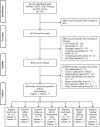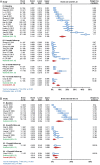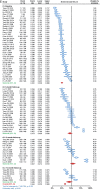Methadone maintenance treatment programme reduces criminal activity and improves social well-being of drug users in China: a systematic review and meta-analysis
- PMID: 25573521
- PMCID: PMC4289728
- DOI: 10.1136/bmjopen-2014-005997
Methadone maintenance treatment programme reduces criminal activity and improves social well-being of drug users in China: a systematic review and meta-analysis
Abstract
Objective: Methadone maintenance treatment (MMT) has been implemented in China since 2004 and has expanded into a nationwide programme. This study aims to evaluate changes in social functioning, family relations and drug-related criminal behaviour among MMT clients in China.
Design: Systematic review and meta-analysis.
Methods: Both English and Chinese literature databases, including PubMed, Chongqing VIP Chinese Science and Technology Journals Database (CQVIP), China National Knowledge Infrastructure (CNKI) and Wanfang Data, were comprehensively searched over the period 2004-2014 for studied indicators. Study selection, quality assessment and data extraction were conducted according to the PRISMA (preferred reporting items for systematic reviews and meta-analyses) Statement. Meta-analyses were conducted using Comprehensive Meta-Analysis Biostat software.
Results: Thirty-eight articles were included in this review (1 in English and 37 in Chinese). The self-reported arrest rate decreased from 13.1% (95% CI 9.1% to 18.5%) at baseline to 3.4% (95% CI 1.5% to 7.7%) and 4.3% (95% CI 1.6% to 11.4%) after 6 and 12 months of MMT intervention, respectively. The rate of drug selling decreased from 7.6% (95% CI 3.8% to 14.8%) at baseline to 1.9% (95% CI 0.6% to 6.2%) and 3.0% (95% CI 1.0% to 8.9%) after 6 and 12 months of intervention, respectively. Similarly, the rates of selling sex for drugs and drug-related crime decreased from 5.3% (95% CI 2.4% to 11.1%) and 9.9% (95% CI 6.8% to 14.2%) at baseline to 1.1% (95% CI 0.5% to 2.3%) and 3.4% (95% CI 2.5% to 4.5%) at 6 months, then to 0.8% (95% CI 0.3% to 1.9%) and 3.4% (95% CI 0.8% to 13.1%) at 12 months after treatment initiation, respectively. In contrast, the rate of employment of clients and the proportion of clients having a good relationship with their family increased substantially from 26.4% (95% CI 22.9% to 30.1%) and 37.9% (95% CI 32.0% to 44.2%) to 41.6% (95% CI 36.6% to 48.0%) and 59.6% (95% CI 48.1% to 70.2%) at 6 months, then to 59.8% (95% CI 52.4% to 66.8%) and 75.0% (95% CI 69.0% to 80.2%) at 12 months after treatment initiation, respectively.
Conclusions: MMT has significantly reduced criminal activity, and improved employment rate and social well-being, of clients of the MMT programme. MMT is an effective measure to help drug users to resume societal and familial functions in China.
Keywords: PUBLIC HEALTH.
Published by the BMJ Publishing Group Limited. For permission to use (where not already granted under a licence) please go to http://group.bmj.com/group/rights-licensing/permissions.
Figures






References
Publication types
MeSH terms
Substances
LinkOut - more resources
Full Text Sources
Other Literature Sources
Medical
